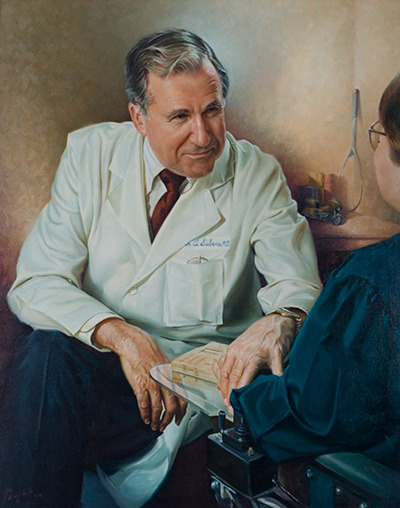Arthur Alexander Siebens

Arthur Alexander Siebens
- Artist:
- Dean L. Paules
- Date:
- 1995
- Medium:
- Oil on canvas
- Dimensions:
- 39 x 31 in.
Arthur Alexander Siebens
1921-1996
Siebens, a director of rehabilitation medicine at The Johns Hopkins Hospital and Good Samaritan Hospital, was born in Atlanta. He received an A.B. from Oberlin College in 1943 and an M.D. from the Johns Hopkins University School of Medicine in 1947. After an internship on the Osler Medical Service at The Johns Hopkins Hospital, Siebens was appointed assistant professor in the department of physiology at the State University of New York.
He served in the U.S. Navy as officer of the cardiopulmonary laboratory at the U.S. Naval Hospital in St. Albans, New York, where he helped establish one of the first cardiac catheterization laboratories. He retained a consultative appointment with veterans hospitals for the next fifteen years. Siebens was appointed professor of physiology at the State University of New York in 1958. The next year, he accepted a position as a professor of pediatrics and physiology, and of rehabilitation medicine at the University of Wisconsin. In 1967, he was named director of the department of rehabilitation medicine at the university.
Siebens returned to the Johns Hopkins University School of Medicine in 1970 as professor of rehabilitation medicine and surgery. He established the department of rehabilitation medicine at The Johns Hopkins Hospital and at Good Samaritan Hospital. He retired in 1994 and became director of pharyngology rehabilitation and research at Greater Baltimore Medical Center.
Siebens’ work with the functionally disabled, in addition to swallowing disorders, included skeletal research in achondroplasia, a genetic disorder that causes dwarfism. He invented a “swallow-safe” diet for people with swallowing impairments resulting from sensory loss in the mouth and throat or damage to the parts of the brain that govern swallowing. He studied pulmonary disease, swallowing disorders, bioengineering devices for people with achondroplastic dwarfism, and orthotic devices for paraplegic and quadriplegic patients.
Siebens was a member of nine professional societies including the American Physiological Society and the American Congress of Rehabilitation Medicine. He also served as an advisor to the Archives of Physical Medicine and Rehabilitation.
"*" indicates required fields
